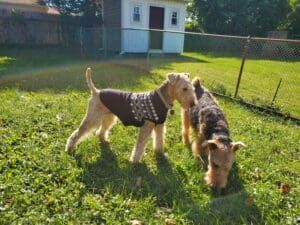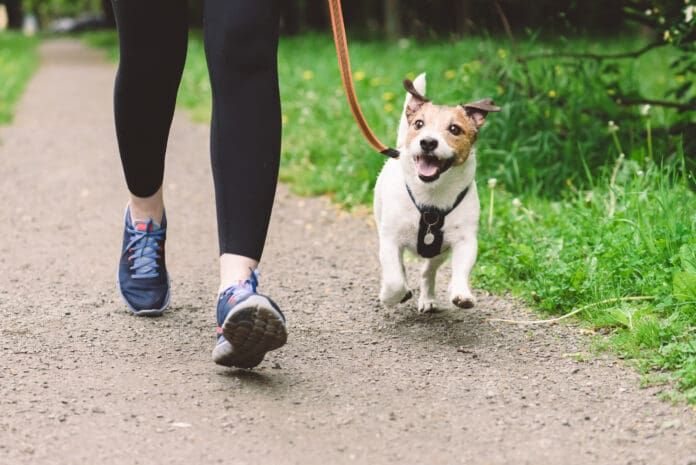Dog or human, nobody likes being bored. While some boredom is inevitable—this is, after all, real life we’re talking about—proper mental stimulation for dogs can be a significant factor in their overall quality of life.
Consistent periods of prolonged boredom can be frustrating for dogs, often leading to the dog trying to come up with her own entertainment to feel better. This often results in undesirable behaviors such as constant barking, nipping at human and dog family members for attention, or chewing on the furniture. A lack of mental stimulation can also contribute to a dog becoming disengaged and depressed, which can be harder to identify. How, then, do we provide good mental stimulation for dogs?
Why Do Dogs Get Bored?
It’s important to note that a lack of activity doesn’t necessarily mean a dog is bored. Dogs do not need to be entertained every waking moment to be happy. In addition, individuals will have different needs. A high-energy thinker—imagine your stereotypical Border Collie—will likely need a lot of focused mental stimulation to be content. Others, like the lovely who-knows-what shelter dog I grew up with, seem to feel as though just living life (with, in her case, a bunch of active kids around to keep track of) is enough to be going on with.
The goal is to find the right balance of rest, play, and work for your individual dog. Pay attention to her body language and behavior. Some signs a dog might be bored include:
- Excessive barking
- Destructive behavior
- Excess energy/zoomies
- Overexcitement
- Listlessness/lethargy
- Anxiety
- Short temper/grouchy
Luckily, there are several easy ways to get your dog engaged and mentally stimulated.
Mental Stimulation for Dogs Through Daily Training
One of the simplest ways to provide mental stimulation for dogs is to do some training on a daily basis. For this purpose, it doesn’t really matter what cues you are teaching your dog. Asking her to pay attention and figure out what you want her to do is what engages her brain and gets her thinking. Teaching something new can be especially useful if she seems bored with the cues she already knows. Picking a few simple tricks is a great place to start.
If that seems daunting, remember that training sessions don’t need to be long to be effective—5-10 minutes a few times a day usually works well. For me, I try to get in a brief training session right before the morning walk, another at lunch or when I wrap up work in the evening, and one more before bed. If you’re short on time, even one 5-minute session a day is worth it.
When life is particularly hectic, I have had good luck with signing up for a training class. While it may seem counterintuitive to take on one more thing when you are already really busy, I find that having a set spot on my schedule every week means I am more likely to make time for training. As an added bonus, going to class means my dog gets the extra stimulation of a trip to a new place with other people and dogs to interact with.

While the way to provide mental stimulation for dogs may change over time, the need for mental stimulation itself does not. Aging and elderly dogs are often at risk of getting less than they need as their ability to move and play diminishes. It can be difficult to find good ways to compensate for the physical and mental challenges that come with old age, but it’s not impossible. It can be difficult to find good ways to compensate for the physical and mental challenges that come with old age, but it’s not impossible.
My dog Suki lived to see 13 and a half—a goodly age for an Airedale—but suffered from some health problems that affected her physically and cognitively as she got older. The long, rambling walks we used to go on fell by the wayside and there were times when simple cues she’d mastered as a puppy just didn’t make sense to her. She was still herself—sassy, dignified, and serene—just more frail and forgetful.
I floundered, trying to figure out how to adapt when the routines we’d had since she was a teeny ball of fluff no longer worked. I could see her beginning to disengage and shut down. It felt like I was failing her.
Around the same time, I started her on physical therapy. Before long, she was going to the PT equipment and asking for sessions. She didn’t always remember what she was supposed to be doing but she was all about doing it. I let go of some of my heartache over what she had forgotten and got back into a training routine. I reminded myself that there was nothing wrong with teaching a sit over and over again. It was new and exciting to her each time and that was what mattered.
Suki began to come back to me, becoming more alert and showing more interest in what was going on around her again. I started taking her on short trips. We even went to the beech, which I’d been avoiding since she didn’t have the strength to walk through deep sand. Instead, I carried her down to the edge of the water. She lit up when she smelled the ocean. For 15 minutes she was like a puppy again, playing in the waves and trotting after seagulls. That was all she had the energy for, but she came home happy and content in a way she hadn’t been in far too long.
As she continued to age and weaken, I went back to some of the early development work I’ve done with young puppies. I brought her fun things to sniff, played music she liked (she had STRONG preferences), and offered her objects in a variety of textures to explore as she lounged in her dog bed. We continued to play those games until the very end of her life.
It took time for me to understand that what had been missing was how to provide good mental stimulation for Suki in her senior years. When I got the message, it made all the difference. Her life—and mine—were far richer for it.
Dog Enrichment Activities: Exercise and Travel
Proper exercise is foundational when it comes to keeping your dog in a good mental place. That said, following the same old path, while good for keeping in shape, can get boring. There are a number of ways to make your walks more mentally stimulating:
- Pick a different route: Even just following your usual path in reverse can make it more exciting for a dog who is used to doing the same thing every day.
- Pause for training: Ask your dog for the occasional sit, down, or other cue that she knows as you are walking. You can even turn sections of the walk into heelwork practice. Build up the number and complexity of things you are asking for over time and don’t be afraid to get fancy with it. The trick to making a walk truly mentally stimulating is to mix it up and keep it fun. However, not every walk needs to be complicated—be sure to vary this type of “working” walk with more relaxed exploratory walks.
- Go with friends: If your dog likes the company of other dogs and/or people, see about arranging a group walk. Bringing others along can add a layer of interest to an otherwise commonplace event.
- Go somewhere different: Taking a walk at a park or around a store that allows dogs is a great way to get some variety.
- Do something else entirely: If your dog is physically healthy enough, varying the type of exercise she is getting, such as going for a run or swim, can be beneficial.
Travel is another good way to provide mental stimulation for dogs. Even if you’re not going out with the goal of getting some exercise, visiting somewhere new—provided your dog does well in the car—is often an exciting break from the norm. These kinds of experiences engage your dog’s brain by offering a plethora of new things to see, smell, and explore.
Dog Sports and Canine Engagement
Signing up for a dog sport can be a great source of mental stimulation for dogs and their humans. Along with providing enrichment, participating in a dog sport is one of the best ways to build the bond between handler and dog. It’s also a whole lot of fun!
Some of the many options include:
- Agility
- Scent work/tracking
- Fast CAT (Coursing Ability Test)
- Dock diving
- Flyball
- Herding
- Canicross
- Rally/obedience
- Heelwork to music
A good way to get started in dog sports is to find a group or club that is actively involved in the one you are interested in. Such groups often teach classes for beginners or can direct you to a good, knowledgeable trainer who does. Be sure to do your research and make sure the group’s approach to the sport aligns with your own. If you are just looking to have fun, signing up with a highly competitive club—or vice versa—will likely end in disappointment.
If nothing is available in your area, don’t lose hope! There are often online classes or video resources you can use to get started.
Playtime and Socialization
Taking time each day to play with your dog can go a long way toward alleviating her boredom. Playtime is a positive way to connect with your dog and get her thinking about how best to hunt down that ball! If your dog likes toys, you can keep her interest fresh—and keep the toys stimulating—by rotating them every few weeks. Some mentally stimulating games are:
- Hide-and-seek: In addition to being mentally stimulating, hide-and-seek is a good game for improving a dog’s recall. To play, find a hiding spot—pick an easy one to begin with such as just stepping out of the room beyond the dog’s line of sight. Call your dog enthusiastically. When she comes to find you, praise her and reward her with a treat or toy. As she gets used to the game, you can move to more difficult-to-find hiding spots.
- Fetch: To teach a dog to fetch, start with an object she is already interested in. Wiggle it around until she’s excited about it, then toss it. Keep throws short to begin with and take a few steps backwards when your dog starts to come back to you. For a more detailed explanation of how to successfully get your dog to play fetch and common mistakes to avoid see “How to Teach a Dog to Play Fetch.”
- Find it: For the simplest version of this game, you can hide a treat in the palm of one hand, close both fists, and hold them out to your dog. When she noses the correct hand, praise her and let her have the treat. Once she has mastered that version, you can increase the difficulty by hiding a treat under a cup and having her search for it among several similar cups.
- Tug: When properly taught, tug—where human and dog each take one end of a toy and pull—can be a great, mentally stimulating game to play with your dog. There are a few ground rules to keep it safe and fun for all involved. First, it should be an invitation only game, meaning that unless you initiate the game, don’t play. Next, teach your dog to release the toy when you ask. Keep in mind that tugging should be done sideways, not up-and-down, to avoid spinal injuries and should be kept gentle for puppies and elderly or frail dogs. For an in-depth discussion of how to play tug with your dog see “Eight Rules for Playing Tug of War With Your Dog.”
Playing and socializing with other dogs is also mentally stimulating. Regular playdates with friendly dogs can be a great way to help your dog stay mentally engaged, especially if she is the only dog in the house. It doesn’t have to be off-leash play. Going on walks with friends is good, too.
Mental Stimulation Toys for Dogs
On the play front, there are a lot of toys on the market these days specifically designed to provide mental stimulation for dogs. Interactive puzzle toys in particular can give a dog a lot to think about. As discussed in “The Best Dog Puzzle Toys,” the trick is finding puzzles that are difficult enough to engage your dog without being so hard the she gets frustrated and gives up. You’ll also need to be prepared to help out if she gets stuck and keep an eye on her while she’s working on them, as most puzzle toys are safest when used with supervision.
Food dispensing toys can also offer a lot of entertainment and mental stimulation for dogs. Among the many options available are snuffle mats, kibble dribblers, toys that can be stuffed with food, slow feeders, and electric dispensers. I usually feed my dog several meals a week via snuffle mat or kibble dribbler rather than her bowl—much to her delight.
For more on how to choose the right food dispenser for your dog see “The Best Food Dispensing Dog Toys.”





